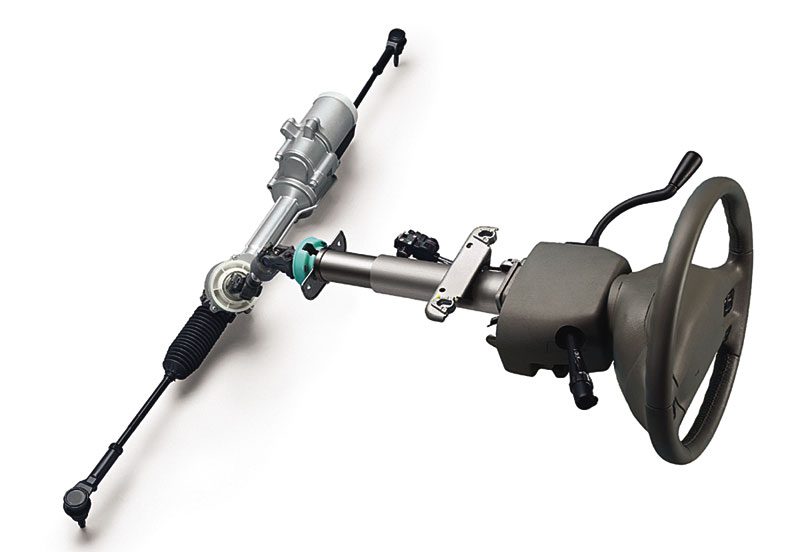
Purpose and device of a steering column of a car
Content
Steering is included in the device of any car. This system allows you to set the direction of a moving vehicle by turning the front wheels. In some modern passenger car models, the steering system is capable of slightly changing the position of the rear wheels. As a result, the turning radius is significantly reduced. You can find out how important this parameter is. from a separate article.
Now we will focus on the key mechanism, without which the car will not turn. This is the steering column. Let's consider what modifications this mechanism can have, how it is regulated, and also how to repair or replace it.
What is a car steering column
The steering mechanism is set in motion by the driver using the steering wheel located in the passenger compartment. It transmits torque to the drive of the swivel wheels. The serviceability of this device directly affects safety while driving. For this reason, automakers pay a lot of attention to the quality of this mechanism, which minimizes its sudden failure. Despite its reliability, the column is also subject to wear and tear, so the driver is obliged to monitor the technical condition of this device.
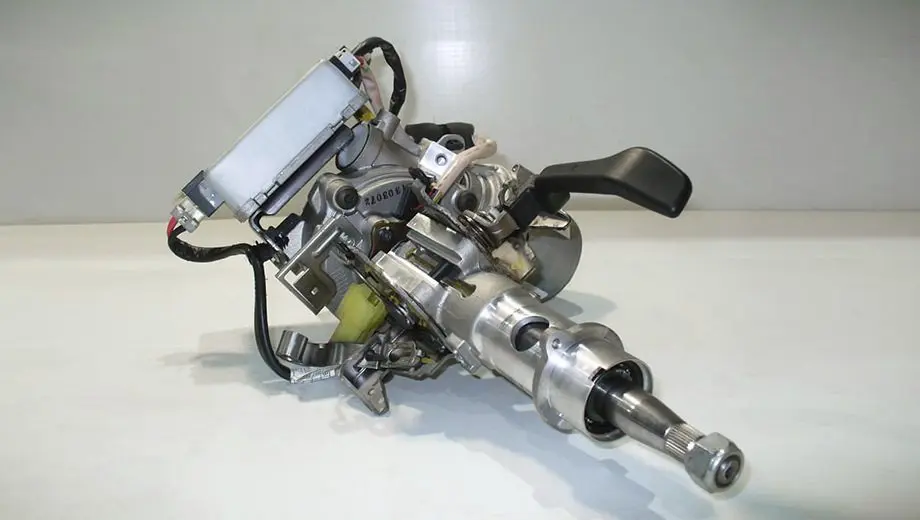
In addition to its direct purpose - to transmit torque from the steering wheel to the turning mechanisms of the car - the steering column also serves as a support for various switches, which should always be at hand. This list includes a switch for light, windscreen washer and other functions needed while driving. On many models, the ignition lock is also located here (in some cars, the engine start button is used instead, and it can be located on the central panel).
This element also ensures safe driving, and its device prevents injury when a frontal impact occurs. The design of a modern speaker consists of several segments (at least two), due to which a frontal collision provokes deformation of the mechanism, and it does not damage the driver's chest in a serious accident.
This mechanism works in conjunction with a mechanical gearbox that converts rotary motion into linear motion. We will talk about the varieties of this node a little later. In the terminology relating to steering, the expression "gear ratio of the RU" is encountered. This is the ratio of the steering angle to the steering wheels. This gearbox is connected to the so-called trapezoid. Its functionality is always the same, despite different design modifications.
This control element, through the steering linkage system, turns the wheels at a different angle depending on the speed of the steering wheel. In some vehicles, this system also tilts the steering wheels, which improves vehicle maneuverability on narrow road sections.
The task of the steering is not only the ability to provide a comfortable turn of the front wheels. An important factor is the ability to return them to their original position. In some car models, systems are installed that change the gear ratio of the steering rack. Among the varieties - active steering AFS... Even in the actuators, there is always a slight backlash. About why it is needed, how to eliminate its excess and what is the allowable value of this parameter, read here.
Steering column device
Initially, the old car received a fairly primitive steering. The steering wheel was mounted on a hinged shaft. The whole structure was in a casing (usually it was also metal). The principle of operation and the function of the steering column has not changed for about a hundred years. The only thing is that automakers are constantly improving this mechanism, making some changes to its design, increasing the comfort of control and safety during an accident.
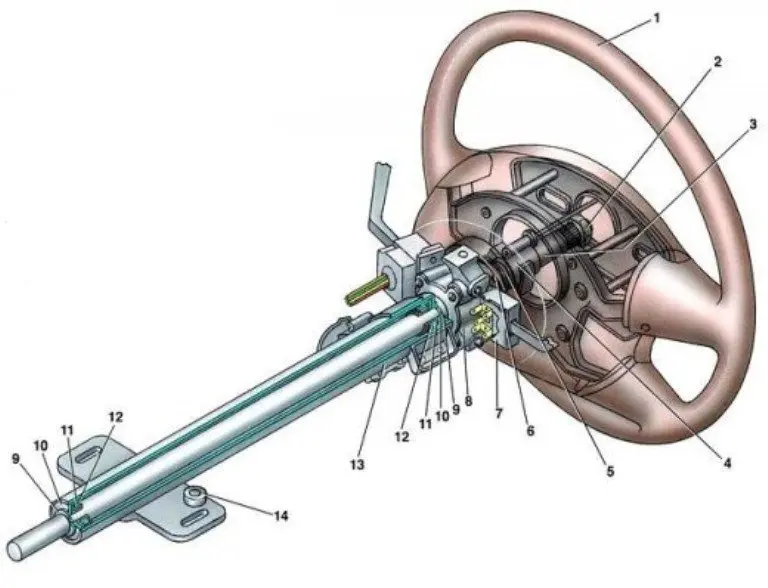
Modern RK consists of:
- Steering and intermediate shaft;
- Mounting sleeve;
- Contact group (activates the ignition of the on-board system of the car, which is discussed in detail in another article). Although it is not part of the speaker itself, this node is associated with it;
- Gears (leading and driven);
- Casing;
- Ignition lock mounting block (if a separate engine start button is not used);
- Mounting block of switches located under the steering wheel;
- Upper body;
- Pylnikov;
- Damper;
- Shaft blocker;
- Fasteners (bolts, nuts, springs, brackets, etc.);
- Cardan transmission (for what other parts of the car this mechanical element is used, read in another review).
The quality of the anthers is of great importance. They prevent foreign particles and debris from entering the mechanisms, which would cause blocking of the control. While the vehicle is in motion, this will inevitably lead to an accident. For this reason, the scheduled maintenance of the vehicle should include diagnostics of the condition of these elements.
So that the load from the weight of the column is not imposed on the actuators, it is attached to the front panel using a strong bracket. This part must also be strong, since it not only takes on the weight of the RC structure, but also prevents it from moving as a result of forces from the driver.
At the base of the steering column, several hinge joints (made of high-alloy steel) are used, which are located in plastic casings. The use of this material ensures the correct operation of the mechanism and prevents a sudden breakdown. Also, in comparison with the first developments, modern RCs are made so that during a frontal collision the shaft folds, so that a powerful blow is not so dangerous.
The key requirements for a steering column are:
- The steering wheel must be firmly fixed on it;
- In the event of an accident, it must ensure the reduction of driver injuries;
- The ability to facilitate the movement of the car due to easy maneuvering on winding sections of the road;
- Precise transmission of driver forces from the steering wheel to the steering wheels.
RK works in the following sequence. The driver turns the steering wheel. The torque is transmitted to the shaft and through cardan transmissions it is fed to the drive gear. This part, in conjunction with the driven gear, determines the number of turns of the steering wheel to fully move the wheels. To make it easier for the driver to turn large wheels in a heavy car, this pair is small in size, which increases the effort on the trapezoid. In modern cars, different types of amplifiers are used for this (read about this in detail here).
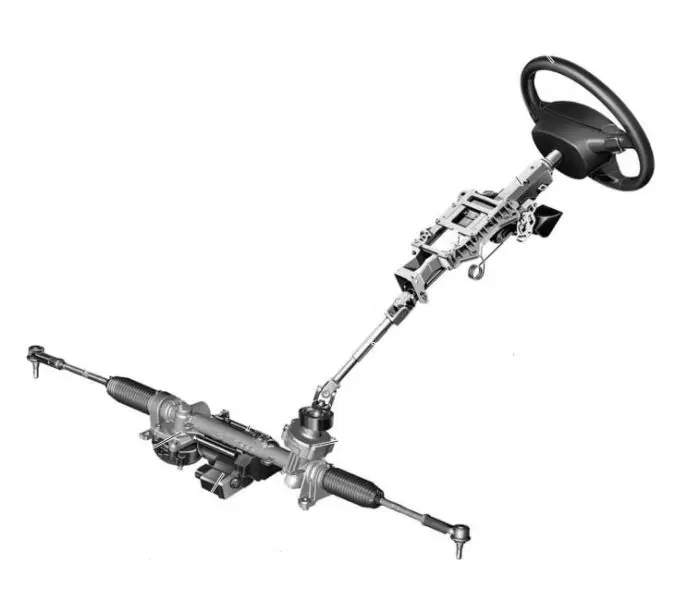
At this moment, the steering rack is activated. We will not delve into the details of the operation of this unit. Details about the device, the principle of operation and various modifications of the element are already available A separate article... This mechanism moves the steering rods in accordance with the direction that the driver himself determines.
Linear motion acts on the steering knuckle of each wheel, making them turn. In addition to other steering knuckle functions, see separately... Since the safety of any car depends on the steering column, it is designed so that breakdowns in it are extremely rare.
The value of using a steering damper
Not all steering column models use a damper. It is rather an additional equipment that provides greater comfort when driving a car. The use of this element is due to poor-quality road surface, due to which vibration is generated in the steering at high speed. This mechanism will certainly be in off-road vehicles, but it can also be equipped with passenger cars.
The steering damper dampens vibrations that occur when the wheels hit bumps or pits. A country road is more likely to fit this description. Despite the fact that the RC with a damper will cost more than the classical modification, in this case the end justifies the means. There are several reasons for this:
- When the steering wheel vibrates while driving, the driver is tense, and he has to constantly adjust the position of the steering wheel, as it feels like the car is going off its path.
- Since the chassis and steering are capable of changing the angles of the position of some elements over time, they need to be periodically adjusted. Such a procedure is called wheel alignment adjustment (for how it is carried out, read in another review). Usually this procedure is carried out at an interval corresponding to 15 to 30 thousand kilometers, depending on the car model. If a damper element is used in the steering, this adjustment can be made much later.
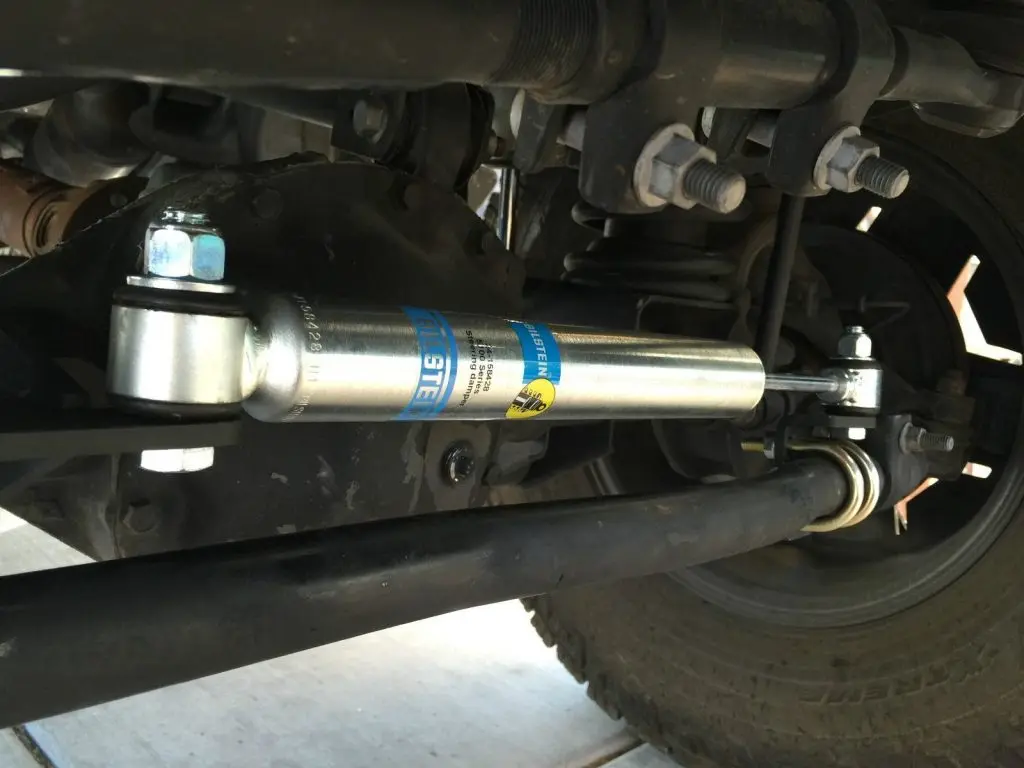
However, this mechanism has one drawback. Usually, when a recoil appears in the steering wheel, the driver realizes that the car has entered an unstable road, and for the safety of the wheels, he slows down. Since the damper dampens vibrations in the steering rods, the steering information content is reduced, and the driver has to focus on other parameters that indicate driving on a bad road surface. But you quickly get used to it, so this factor is not critical, because of which such a modification of the RC should not be used.
Features of the unit and design
The design of a modern steering column may have additional elements. The list includes:
- Steering blocker;
- Adjusting mechanisms.
At the expense of the steering lock, this is an external device that allows the car owner to block the column shaft so that no one else can steal the car. This element refers to the car security system (for more details on what other means allow you to protect the car from theft, read here). The blocker device includes a stopper with a disc lock. The blocker is not removed, but is attached to the shaft during the assembly of the car on the conveyor. Unlocking occurs with the ignition key inserted into the ignition lock and small turns of the steering wheel.
The device of modern RK also includes mechanisms that allow you to change the position of the speaker. In most cases, the inclination of the structure is adjusted, but in some cars there is also an adjustment of the steering wheel departure. The budget version has a mechanical principle of operation. But in more advanced models, this process is controlled by electronics (it depends on the vehicle configuration).
If the on-board system of the car has a memory of the position of the RK, seats and side mirrors, then with an active ignition system, the driver adjusts the position of all these elements to suit his parameters. After the engine is turned off and the driver deactivates the ignition, the electric drives of all these elements bring them to the standard position. This automatic setting makes it easier for the driver to get on and off. As soon as the key is inserted and the ignition is activated, the electronics will set the last value.
As mentioned a little earlier, torque transmission can be carried out in several ways. Consider three types of connections between the RK shaft and the steering trapezoid. Each type of structure has its own efficiency value.
"Gear-rack"
This modification is considered optimal, and it is more often used in modern cars. This design is used in vehicles with independent pivot wheel suspension. The rack and pinion steering mechanism includes the steering rack housing and the mechanical transmission from the pinion to the rack. The system works as follows.
The gear is attached to the steering column shaft. It is permanently engaged with the rack teeth. When the driver turns the steering wheel, the gear rotates with the shaft. The gear-rack connection provides the transformation of rotational movements into linear ones. Thanks to this, the staff moves to the left / right. Steering rods are attached to the steering rack, which are attached to the steering knuckles of the wheels by means of hinges.
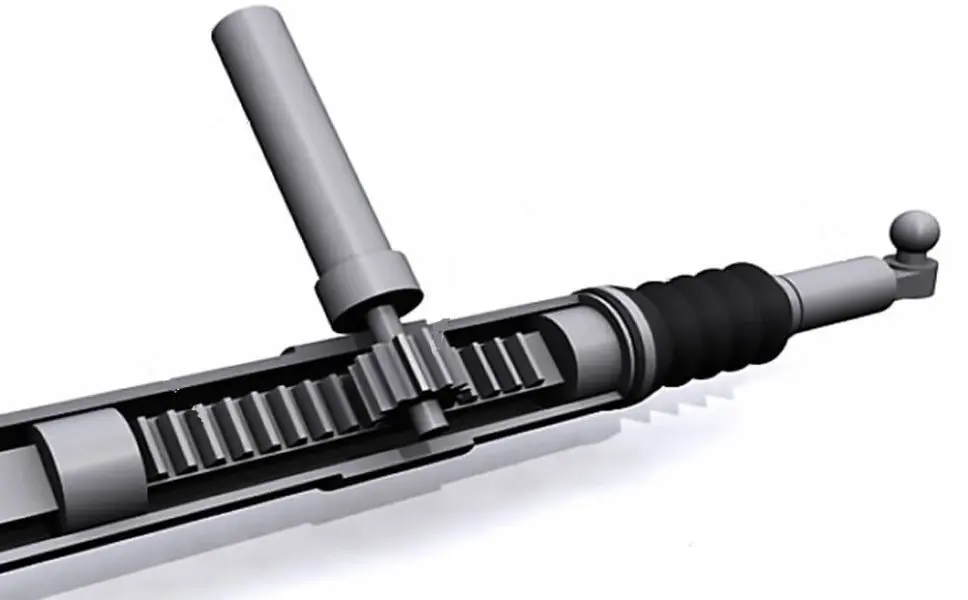
Among the advantages of this mechanism are:
- High efficiency;
- Simplicity of construction;
- The design has a small number of rods and joints;
- Compact dimensions;
- Affordable cost of the new mechanism;
- Reliability of work.
The disadvantages include the strong sensitivity of the mechanism to the characteristics of the road surface. Any bump or hole will certainly transmit vibration to the steering wheel.
"Worm-roller"
This design was used in older cars. Compared to the previous modification, this mechanism has a lower efficiency and a more complex design. It can be found in the steering mechanisms of domestic car models, light trucks and buses. The design of such a transmission consists of:
- Vala;
- Worm and roller transmission;
- Carter;
- Steering bipod.
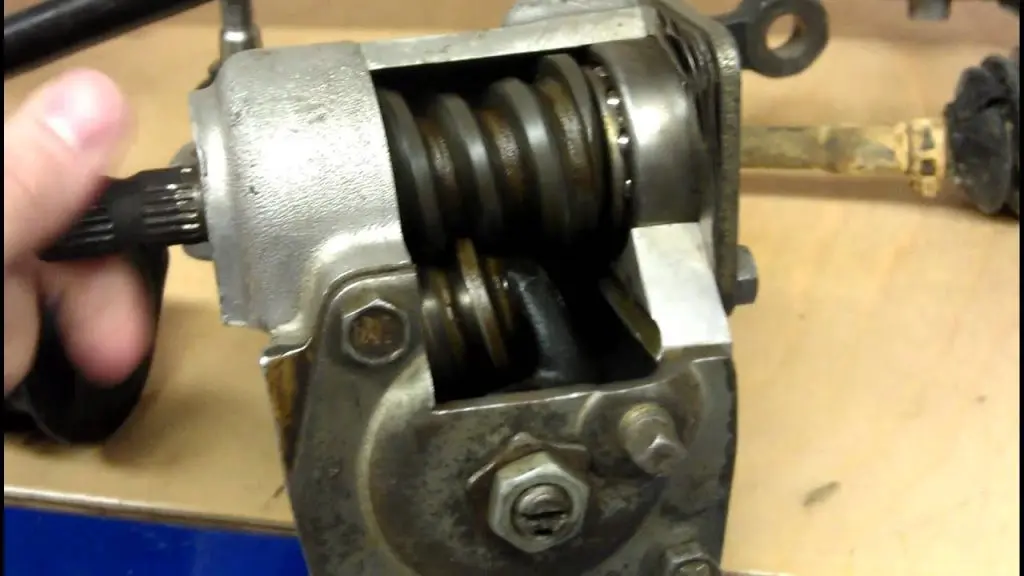
As with the modification mentioned earlier, the roller and the shaft worm are permanently engaged. The lower part of the shaft is made in the form of a worm element. A roller is installed on its teeth, attached to the steering arm shaft. These parts are located in the crankcase of the mechanism. The rotational movements of the shaft are converted into translational ones, due to which the trapezoid parts change the angle of rotation of the wheels.
The worm design has the following positive points:
- The wheels can be turned at a greater angle compared to the previous gear;
- When driving on uneven roads, shocks are damped;
- The driver can make great efforts to turn the wheels, and the transmission will not be affected (especially important for trucks and other large vehicles);
- Due to the large steering angle, the car has good maneuverability.
Despite these advantages, the worm-type steering has several significant disadvantages. Firstly, this design consists of a larger number of parts that need to be adjusted. Secondly, due to the complexity of the device, this modification of the steering is much more expensive compared to the previous analogue.
Screw type
According to the principle of operation, the screw mechanism is similar to the worm version. The design of this modification consists of:
- Threaded steering shaft;
- Nuts;
- Toothed rack;
- Steering arm with a toothed sector.
At the moment of turning the steering wheel, the propeller teeth turn. A nut moves along them. To reduce friction between the teeth of these two parts, rollers are placed between them. Thanks to this, the screw pair has a long working life. The movement of the nut sets in motion the toothed sector of the steering arm, which is connected with the outer teeth of the nut. This moves the steering rods and turns the wheels.
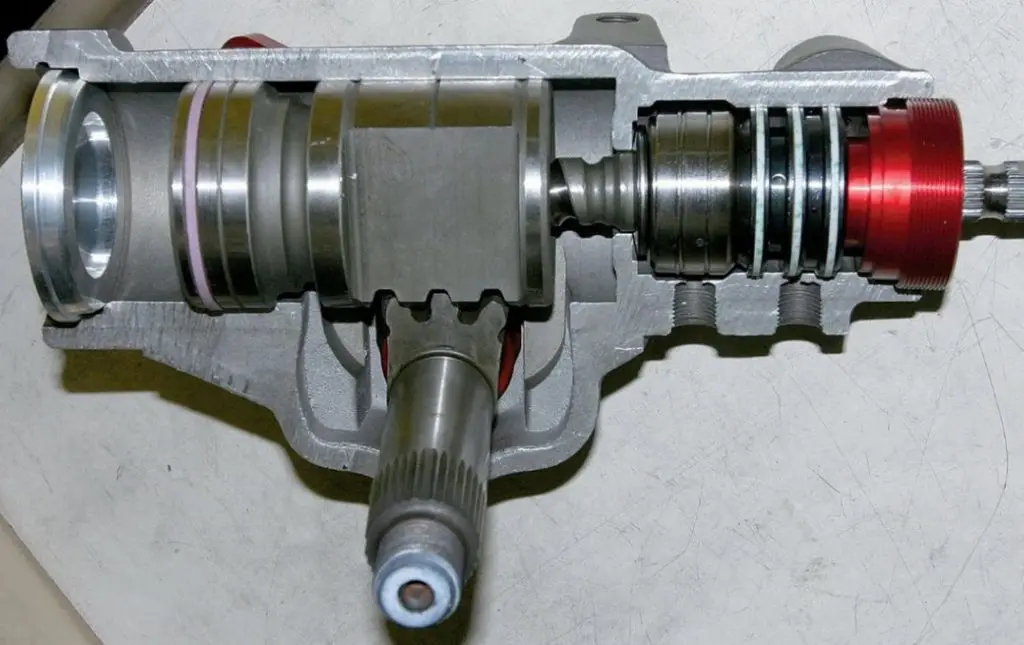
This transmission provides the highest efficiency. Typically, such a transmission can be found in the steering of trucks, buses, as well as executive cars.
How and where is the steering column attached
As mentioned earlier, the steering column is not only capable of transmitting different amounts of torque from the steering wheel to the steering wheels. It must also withstand significant mechanical stress from the driver's hands. Each motorist has his own physical strength, and automakers perform the most secure fixation of the mechanism case. The reason for this is the habit of many drivers to leave the car, using the steering wheel as an armrest or a handle to hold on to.
In order for the structure to remain in place in the case of a physically strong car owner, it is not mounted on the dashboard, but on the front panel of the body using a powerful bracket. This node does not need to be checked periodically. But if the driver noticed a backlash of the structure itself (not the steering wheel), then you should pay attention to its fastening so that at the wrong moment the structure does not fall off, although this happens extremely rarely, and then after inattentive repairs.
Steering column adjustment
If the car has an adjustable steering column, even a beginner can handle steering wheel adjustment. To do this, you need to take a comfortable position in the driver's seat, and adjust it first (for how to do this correctly, read here). Then the adjustment latch is squeezed out and the column is moved to a comfortable position. The key factor here is hand position.
If you put both hands on the top of the steering wheel, then in an extended state they should not touch the steering wheel with their palms, but with the wrist joint. In this case, the driver will be comfortable driving the vehicle. More details on how to properly hold the steering wheel (this applies to beginners) is available A separate article.
When adjusting the position of the RK, it is imperative that the machine is stationary. In no case should you do this while the car is moving. After adjustment, you must make sure that the structure is firmly fixed. To do this, it is enough to slightly push the steering wheel and pull it towards you. In electric models, this procedure is even easier by pressing the appropriate key.
How to repair the steering column?
Despite the fact that the RK is a reliable mechanism, sometimes malfunctions occur in it, which in no case should be ignored. The very first warning sign is the appearance of increased axial play or free play in the plane. In the first case, this is a sign of a malfunction of the spline connection or the development of hinges. In the second, there are problems with fastening to the bracket.

In addition to increased backlash, symptoms of faulty steering include:
- Heavy rotation of the steering wheel;
- Creaks when driving a car;
- Leakage of grease.
If the steering wheel turns tight during driving (when the car is stationary, in models without a power steering the steering wheel will always turn tightly), you should look for the reason in:
- Incorrect adjustment of wheel alignment;
- Deformation of a specific part of the transmitting force of the mechanism (it can be a trapezoid, steering rack or column cardan);
- Installation of unsuitable parts (if a tight steering wheel began to be observed after repairing the steering);
- Tighten the swingarm nut tightly.
Leakage of grease is often due to the fact that the oil seals have worn out their service life. The same malfunction occurs when the repair is negligent (the crankcase bolts are poorly tightened) or when the crankcase cover gum is worn out.
The appearance of squeaks may be due to:
- Increased clearance in wheel bearings;
- Poor fastening of the steering link pins;
- Increased clearance of bushings and pendulum;
- Exhausted bearings;
- Poor attachment of the swing arms.
In some cases, the steering cannot be repaired without removing the steering column. Let's consider the sequence of this procedure.
How to remove a column
To dismantle the steering column, you need:
- Disconnect the battery terminals (for how to do this correctly and safely, see in another article);
- Dismantle the steering wheel and remove the column cover;
- Unscrew the nut from the bottom of the column connecting the rods to it (this will require a good lever);
- Unscrew the fastening of the structure to the side member. For convenience, unscrew the wheel from the driver's side (front);
- Dismantle the tightening bolt on the spline connection;
- Unscrew the shaft seal, and the shaft itself is removed into the passenger compartment.
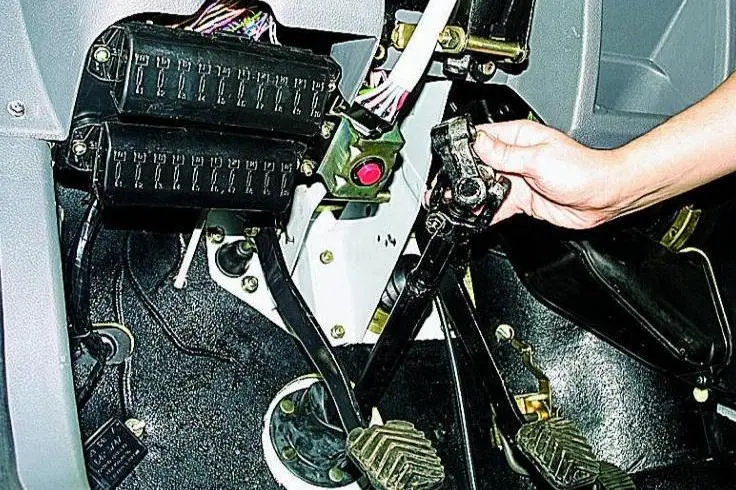
After the column has been successfully dismantled, we proceed to repair it. In some cases, parts can be replaced or the entire structure will have to be changed completely. During the replacement process, it is also worth purchasing new seals and fasteners (bolts and nuts).
When replacing a bearing, you must adhere to the same scheme for removing the column. Further, the shaft assembly with the bracket is clamped in a vice. You can release the bearing by knocking the shaft out of the bracket. Although the blows are effective with a hammer, it is important to be careful not to spill the end of the shaft. To do this, you can use a wooden spacer, for example, a thick oak block.
New bearings are installed with the narrow part outward. Next, the products are pressed in until they rest against the stopper. The second bearing is pressed in the same way, only this time the shaft itself is fixed in the vice, and not the bracket. In the event of a breakdown of the universal joint cross, the entire structure changes completely.
At the end of the review, we offer a small video instruction on how to dismantle the steering column on a VAZ 2112:
Questions and answers:
Where is the steering column located? This is the part of the steering, which is located between the steering wheel and the steering rack (located in the engine compartment and connects the swivel wheels to the mechanism using rods).
How is the steering column arranged? The shaft on which the steering wheel is mounted. The housing on which the steering column switches and the ignition switch are attached. Cardan shaft with crosspiece. Depending on the modification, dampers, adjustments, blocking.
